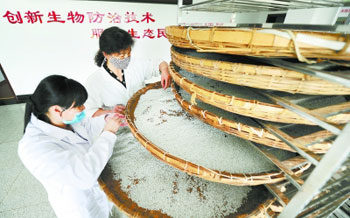If we don't plant corn, we will first investigate the pesticide residues.
The original title: an important step that can not be ignored in adjusting the structure of "sickle bend".
Long residual herbicide damage should be avoided

Data map
The most important thing for farmers in the sickle bend area this year is the adjustment of the corn structure. If you don't grow corn, what will you grow? When farmers are making plans, there is one problem that they may not have thought of. A few days ago, at a training course on weed control techniques for maize structural adjustment in the "sickle bend" area held by the National Agricultural Technology Center in Keyouqian Banner, Inner Mongolia, a number of herbicides focused on reminding that atrazine and nicosulfuron commonly used in corn fields are long residual herbicides, which will cause drug damage to the next crop, and some long residual herbicides will remain for sensitive crops for as long as two or three years. Therefore, it is necessary to decide what to plant according to the use of herbicides before corn replanting, so as to avoid unnecessary losses. In this regard, experts also give countermeasures and technical suggestions for screening and popularizing efficient and safe new alternative herbicide varieties, vigorously integrating the technology of reducing the use of herbicides, and scientifically guiding the layout of follow-up crops. How to control weeds scientifically and safely in cornfields and subsequent crops? Let's listen to the experts.
Li Xiangju, a researcher at the Institute of Plant Protection, Chinese Academy of Agricultural Sciences, ★
Unreasonable use of herbicides restricts structural adjustment of maize
The perennial area of weeds in China is more than 1.4 billion mu, accounting for about 85% of the grain sown area. Weeds compete with crops for water, fertilizer, glory, spread diseases and insect pests, release toxic substances, and reduce crop yield and quality, resulting in a 10% to 15% reduction in crop yield. Chemical control of weeds is fast, efficient and low-cost, which can recover more than 21 million tons of grain loss every year, but the unreasonable use of herbicides will also cause frequent drug damage, poor efficacy, cost increase and other problems.
The unreasonable use of herbicides in "sickle bend" area has become the limiting factor of maize structure adjustment. The northeast region (the three eastern provinces and Inner Mongolia) is more prominent. Northeast China is not only a key corn producing area in China, but also a province with a large use of herbicides in corn fields. In 2015, the sown area of corn in the four provinces and regions of Northeast China was 254 million mu, and the total use area of herbicides was 308 million mu, with an average of 1.2 times per growing season, with a total use of 300 mu and 500 grams per mu, with a total usage of 56200 tons. Long-term and large-scale use of long-residual herbicide atrazine and its compound preparation in maize production in Northeast China leads to the accumulation of atrazine residues in the soil, affects the growth of subsequent crops, and becomes the bottleneck of crop rotation and planting structure adjustment.
So how to use herbicides scientifically and safely? In our investigation in Jilin, we found that farmers, large grain growers, cooperatives and so on all have the concept of "weeding". In fact, weeds have an economic weeding threshold, that is, the level of weed population when the loss caused by weeds is equal to the cost of control. For example, the eco-economic threshold of Magnolia mandshurica control under different weeding effects and yield levels in Beijing corn field is 4.62-7.11 plants / m2, and weed control can be avoided when it is lower than or equal to this value.
It is important to understand the herbicide spectrum of herbicides. For example, Acetochlor is for Gramineae weeds, atrazine is used for broadleaf weeds, nicosulfuron is used for Gramineae weeds and broadleaf weeds, nitrosulfone and benzopyrazolone are used for broadleaf weeds. Only by fully understanding these, can we achieve a good target effect. Attention should be paid to the rotational use of herbicides in order to delay weed resistance and slow down community succession. Herbicides should be used in the insensitive period of crops and should not be overused. Attention should be paid to avoid affecting the next crop and drift drug damage, successive years of drug use, soil drought, less rain, turning over the soil layer and high organic matter content will increase the pesticide residue in the topsoil layer and affect the growth of the next crop.
It is necessary to select herbicides with low toxicity, reduce the use of herbicides, select high-quality application machinery, reduce drift and volatilization, and apply drugs to the target. The effective utilization rate of pesticides by conventional spraying method is 20% to 30%. Mobile spraying, adding auxiliaries, optimizing droplet diameter, reducing spray volume and increasing anti-drift device can improve the utilization rate. It can be assisted with straw mulching + post-seedling application, increasing organic fertilizer, plastic film mulching + pre-seedling application, optimizing crop varieties and reasonable close planting to reduce the amount of herbicides.
Wang Guangxiang, researcher of Institute of Plant Protection, Jilin Academy of Agricultural Sciences, ★
Attention should be paid to the chemical control of the crops after corn.
The corn field uses atrazine + Acetochlor (Metolachlor, Metolachlor) + 2mae4murD isooctyl ester. The annual amount of atrazine is less than 1710 grams (active ingredient). Spring soybean can be planted carefully in the next crop. The annual usage of atrazine is 1710-2400g (active ingredient). The drug damage of spring soybean is serious in the event of rainfall and sufficient sunshine after rain, and the yield is reduced obviously. it is not recommended to plant spring soybean, but can plant silage corn, fresh corn, sorghum, millet and so on. the annual use of atrazine is higher than 2400 grams (active ingredient), and only silage corn, fresh corn or popcorn can be planted in the following crop.
The corn field uses the plot of azinachlor + Acetochlor (Metolachlor, Metolachlor) + 2mem4murD isooctyl ester, and then can plant soybean, silage corn, fresh corn, potato, peanut and so on.
The plots of azosulfochlor (or chlorosulfochlor) + Acetochlor in corn field can be intercropped with soybean and rotation.
Corn fields using nicosulfuron (nitrazolone, oxazolone) + atrazine + safety agent or reduced use of atrazine (soil treatment changed to stem and leaf spray treatment-20% reduction by 50%, adding functional auxiliaries-reduction by more than 20%, using standard nozzles, etc.) Silage corn, fresh corn, potatoes, spring wheat, spring soybeans, peanuts, miscellaneous beans, rape, melons, vegetables, fruit trees or forage grass can be planted after 3 years.
The general principle of chemical weeding in the following crops is to effectively control the harm of weeds under the premise of crop safety, and to select appropriate herbicide varieties and application methods according to crops; determine the correct dosage of herbicides according to soil types (sandy loam, light alkaline soil, meadow soil, loam, black loam, etc.) and soil organic matter content; determine the correct use dose of herbicides according to climatic conditions (soil moisture or air temperature).
Silage, fresh corn
Thiosulfuron + isoxazolone + safety agent: soil treatment before maize seedlings or early stem and leaf spray treatment after corn seedlings; wheat should not be planted in subsequent crops; slightly inhibited potato, but did not affect late growth and yield; other crops such as sorghum and legumes are safe.
Nitrosulfonone + nicosulfuron + safety agent: used at 3-5 leaf stage after corn seedling.
Methyl azinoxalate + Roque sulfone: pre-seedling soil treatment of corn. Metolachlor + atrazine + nitrosulfone: 47.2% suspension emulsion 6 kg per hectare for pre-seedling soil treatment of corn.
Benzopyrazolone (+ dimethachlor or diphenoxazolic acid): spray treatment of stems and leaves before 8-leaf stage of corn.
Maicaowei + safety agent: before the seedling and before the 7-leaf stage after the seedling. Thiosulfuron + cyclosulfonic ketone + safety agent: used before 7-leaf stage after corn seedling.
3% formylaminosulfuron can disperse oil suspension: 45 to 54 grams per hectare of stem and leaf spray treatment to control Gramineae weeds and some broad-leaved weeds.
When 20% chlorofluoropyloxyacetic acid EC was used to control broad-leaf weeds, especially when the resistant weed Abutilon abutilon was more than 210 grams per hectare, the stems and leaves of corn were bent to one side, and the leaves curled up for 3 to 4 weeks.
soybean
Soil closure treatment of soybean field:
Zolazosulfonamide: the content is 80%, with an effective amount of 30 grams per hectare, treated with soil spray before sowing after sowing, and 750 litres of water per hectare (+ amides or pendimethalin or fluthiachlor-substituted amides). This variety is suitable for mixed cropping, intercropping and rotation of rice and beans.
- Prev

"soil method" has great wisdom for Trichogramma to become "rice too old".
"soil method" has great wisdom for Trichogramma to become "rice too old".
- Next

The three Gorges passenger ship is gradually withdrawn from the market and changed to a freighter to avoid idling.
The three Gorges passenger ship is gradually withdrawn from the market and changed to a freighter to avoid idling.
Related
- A course of planting techniques and methods on how to grow carrots
- How to plant the latest tulips?
- Is it better to pick tea in the morning or in the afternoon? When is the best time for tea to be picked? what is the third or fifth tea?
- Launch Yuanxiao Happy combination Haocha + Tea Yuan healthy Taste
- Penghu Tourism "Fireworks 20 Parade with You"
- 2022 West Lake Happiness holds "Digital Revitalization Voucher" and draws iphone13 and laptop.
- Banqiao Fuzhou social houses are designed to change start-up combined with police elimination to create a safe and livable environment
- The convenient measure of "mechanical weeding" in Xinbei has been abused and the Agriculture Bureau has imposed heavy penalties on the illegal land consolidation.
- Changgeng University Joins Hands with Four Memory Factories to Rescue Memory Talent Shortage
- The list of Taiwan's top 100 MVP managers is listed by the Director-General of the Farmers' Association of Sanxia District.

